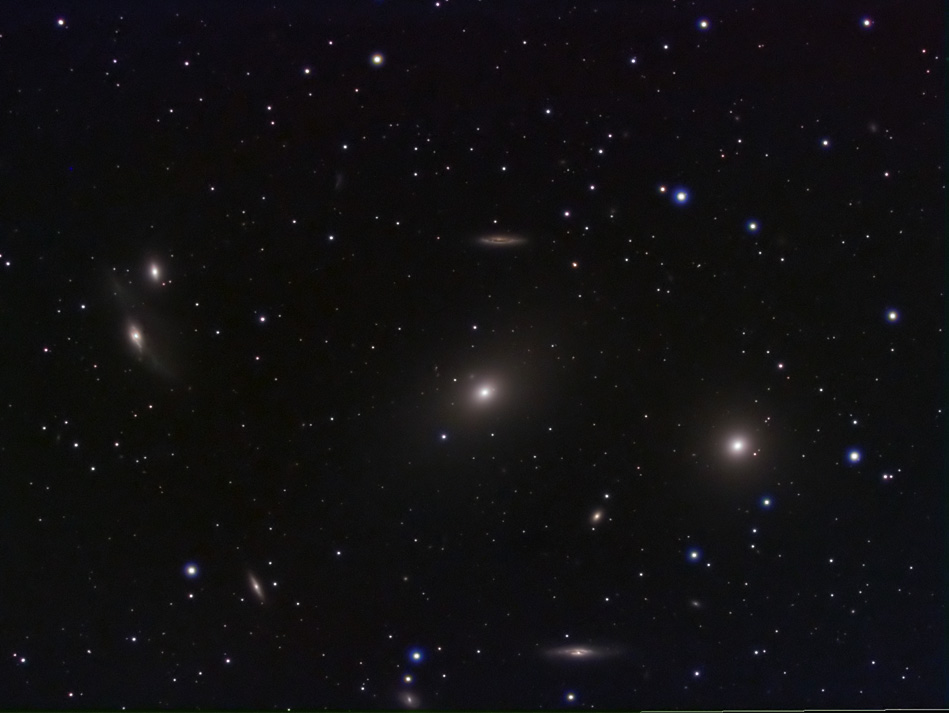
includes not only M84 and M86, but also M88, M89, M90, NGC 4478, and many other Virgo Cluster galaxies.)
(Jon Talbot)
Charles Messier discovered M 84 and M86 on March 18, 1781 and subsequently added both to his catalog.
Describing M84, Messier noted:
“Nebula without star, inVirgo; the center is a bit brilliant, surrounded with a slight nebulosity: its brightness & its appearance resemble that of those in this Catalogue, No.s 59 & 60.”
M86 was described by Messier as:
“nebula without star, inVirgo, on the parallel & very near to the nebula above, No. 84: their appearances are the same, & both appear together in the same field of the telescope.”
John Herschel catalogued M84 as h 1237 and later added it to the General Catalogue as GC 2930, describing it as:
“Very bright; pretty large; round; pretty suddenly brighter toward the middle; mottled.”
M84 is an E1 Hubble elliptical galaxy and M86 is an E3 elliptical galaxy.
M84 is situated in the inner core of the Virgo Cluster, a region populated with galaxies, including M49, M60, M86, M87. the edge-on spirals NGC 4388 and NGC 4402, the elliptical galaxy NGC 4387, the barred spirals NGC 4413 and NGC 4425, and the interacting galaxies NGC 4438 and NGC 4435. M84 is part of Markarian’s Chain, a stretch of galaxies that appear in a curved line when seen from Earth and the subject of the next Cosmic Duets writeup. Named after Armenian astrophysicist Benjamin E. Markarian, who discovered the galaxies’ common motion in the early 1960s. Some of the galaxies are superimposed, but others appear to move coherently.
Studies of radio wavelengths and images taken by the Hubble Space Telescope in 1997 have revealed two jets of matter emanating from the core of M84 and a disk of rapidly rotating stars and gas, which indicates that the galaxy contains a supermassive black hole at its centre. The black hole has an estimated mass of 1.5 billion solar masses.
M86 is also a member of the inner core Virgo Cluster. M86 is experiencing ram pressure stripping and losing gas as a result of moving through the Virgo Cluster at such a high velocity. The galaxy is leaving behind an enormous trail of hot gas, visible in images taken by the Chandra X-ray Observatory.
M86 is approaching the Milky Way at 244 km/s (419 km/s according to some sources), which is unusual for a member of the Virgo Cluster because the entire cluster is receding from Earth at an average velocity of 1,000 km/s. M86 displays the highest blueshift (fastest approaching velocity) of all Messier objects. It seems to be moving toward Earth because it is really moving towards the center of the Virgo Cluster rom the opposite side, thus explaining the blueshift. Because of its enormous mass, the cluster’s core has a strong gravitational field, one that can accelerate any galaxy’s velocity to that observed in M86. For example, IC 3258, another member of the cluster, is approaching us at 517 km/s.
Although this Cosmic Duet can be observed through a 4” refractor in dark skies, this author has found this pair much more satisfying to observe through a 130 mm apochromat refractor or an 8” SCT. The extra aperture over 4” helps to spot additional Virgo cluster objects in the field-of-view. Medium-low to medium magnifications are appropriate.